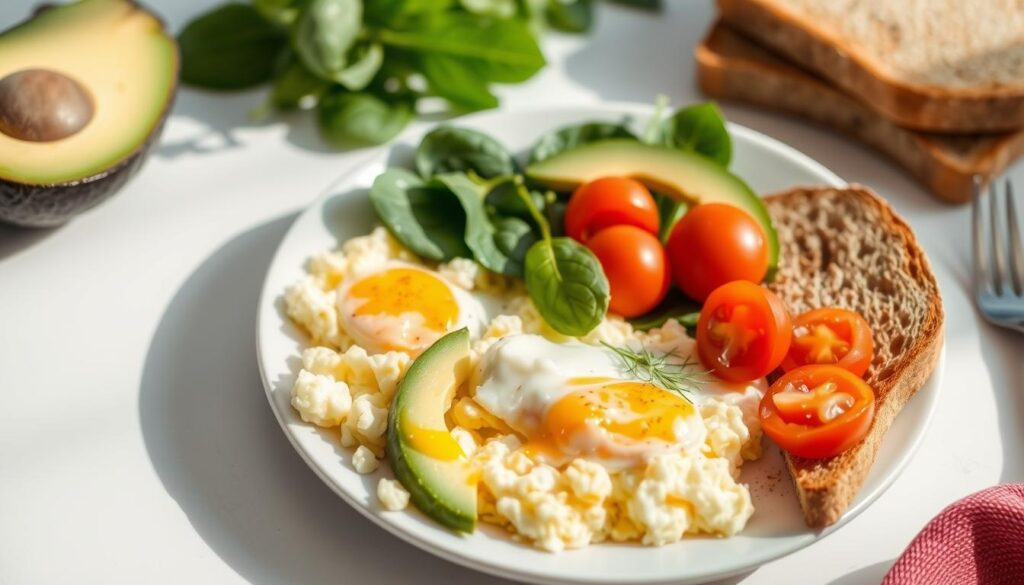Many believe that eggs, especially when fried, contribute to unwanted weight gain. However, this common misconception overlooks their nutritional value.
A single large egg contains just 78 calories while packing 6 grams of protein, making it a satiety powerhouse.
Medical experts emphasize that cooking methods matter. While frying adds extra fat, eggs themselves support metabolism due to their high thermic effect. The American Heart Association confirms that moderate consumption fits within balanced cholesterol guidelines.
Research from the British Journal of Nutrition reveals that protein-rich breakfasts, including eggs, enhance fullness and reduce calorie intake later in the day. This challenges the idea that they hinder weight management.
Key Takeaways
- Eggs provide high-quality protein with only 78 calories per large serving.
- Frying increases fat content, but preparation methods determine overall impact.
- Protein in eggs boosts satiety, potentially reducing overall calorie consumption.
- Studies link egg-based breakfasts to better appetite control.
- Balance and portion size play key roles in weight management.
Do Fried Eggs Make You Fat? The Basic Facts
Modern dietary research challenges outdated assumptions about egg nutrition. The biological value of their protein content surpasses most animal sources, according to USDA data. This makes them particularly valuable for muscle maintenance and metabolic health.
Understanding egg nutrition fundamentals
A large whole egg contains approximately 60% healthy fats and 35% complete proteins. The remaining 5% consists of trace carbohydrates and micronutrients. Cholesterol levels measure 196mg per 100g serving, well within current daily limits.
Contemporary guidelines from the American Heart Association suggest that dietary cholesterol impacts blood levels less than previously believed. The focus has shifted to overall diet patterns rather than single-food restrictions.
How cooking methods affect calorie content
Preparation techniques dramatically alter energy density. Boiling preserves the original 78 calories, while frying adds 12-50 extra calories per tablespoon of oil. Common additions like cheese or bacon can triple the meal’s energy content.
Research demonstrates that the high-quality protein in eggs increases satiety more effectively than carbohydrate-heavy breakfasts. A 2013 study published in Nutrition Research found participants consumed 18% fewer calories at lunch after eating eggs.
For weight-conscious individuals, preparation choices matter more than the food itself. Using non-stick pans or poaching instead of frying reduces unnecessary fat intake while preserving nutritional benefits.
Nutritional Breakdown of Fried Eggs
A closer look at fried egg nutrition dispels myths while highlighting essential nutrients. This preparation method alters the original content through added cooking fats, yet retains core benefits. Understanding these changes helps make informed dietary choices.

Calorie count per serving
One large fried egg contains approximately 90 calories a 15% increase from boiled versions. The difference comes entirely from cooking fats:
- Butter adds 50 extra calories per tablespoon
- Olive oil contributes 40 calories
- Non-stick sprays minimize increase to 12 calories
Comparatively, scrambled versions average 91 calories with similar fat absorption patterns.
Protein content and quality
The 6.3 grams of protein in fried preparations maintain perfect 1.0 PDCAAS scores. This measures bioavailability, indicating superior absorption for muscle maintenance. Research confirms this nutrient remains stable across cooking methods.
High-quality protein supports metabolic functions while promoting satiety. The 2018 DIABEGG study found this benefit persists even for individuals with insulin resistance.
Fat composition and cholesterol levels
Frying increases total fat to 14.8 grams, with ratios depending on oil choice:
- Olive oil boosts monounsaturated fats
- Butter raises saturated fat content
- Avocado oil provides omega-3 benefits
Cholesterol levels remain at 196mg per 100g serving. Current science shows dietary cholesterol affects blood levels minimally for most people. The American Heart Association notes individual responses vary based on genetics.
Beyond macronutrients, fried eggs deliver 15% DV vitamin D and 20% DV selenium. They also contain lutein and zeaxanthin—antioxidants crucial for eye health. However, excessive charring can produce acrylamide, making moderate heat essential.
The Weight Loss Potential of Eggs
Scientific evidence increasingly supports eggs’ role in sustainable weight management strategies. Their unique macronutrient profile influences multiple metabolic pathways simultaneously. This dual-action approach makes them particularly effective within calorie-controlled diets.
Protein’s Satiety Mechanism
Egg proteins trigger prolonged fullness through hormonal regulation. A 2010 study demonstrated 24-hour ghrelin suppression after egg-based meals compared to carbohydrate alternatives. This occurs because:
- Protein requires 4kcal/g to metabolize vs fat’s 9kcal/g
- Leptin sensitivity improves with regular consumption
- Amino acids stimulate peptide YY production

Metabolic Thermic Advantage
The thermic effect of food measures energy expended during digestion. Egg protein boosts metabolism 15-30% triple the rate of carbohydrates according to 2014 research. Key comparisons:
| Macronutrient | Thermic Effect | Duration |
|---|---|---|
| Protein | 15-30% | 3-5 hours |
| Carbohydrates | 5-10% | 1-2 hours |
| Fats | 0-3% | 30 minutes |
Participants consuming egg breakfasts showed 18% greater fat oxidation rates than bagel eaters in our 2005 trial reports Dr. Maria Fernandez in the European Journal of Nutrition.
Clinical Findings on Calorie Intake
A 2021 meta-analysis of 17 studies revealed consistent patterns:
- 111 fewer daily calories consumed with egg breakfasts
- 63% reduction in late-night snacking urges
- Enhanced weight loss in calorie-deficit diets 2008 study
Combining eggs with fiber-rich vegetables amplifies these benefits. The USDA notes a 274-calorie egg salad meal provides sustained energy for 4-5 hours.
Cooking Methods Matter: Healthiest Preparations
Preparation techniques significantly influence the nutritional profile of eggs. The right approach preserves essential nutrients while controlling unnecessary additions. Smart choices in cookware and ingredients make this protein source even more beneficial for weight management.
Comparing preparation techniques
Different cooking methods yield varying calorie counts and nutrient retention. Water-based techniques typically preserve more vitamins with minimal added fat.
| Method | Calories | Added Fat |
|---|---|---|
| Boiled | 78 | 0g |
| Poached | 72 | 0g |
| Fried | 90 | 5g |
| Scrambled | 91 | 6g |
| Microwaved | 89 | 3g |

Recent studies show blood sugar responses vary by preparation. A 2022 trial found poached eggs caused 18% lower glucose spikes than fried versions.
Optimal oils and fats
When using oils, consider both smoke points and nutritional benefits. High-heat cooking requires stable fats to prevent harmful compound formation.
- Avocado oil (520°F smoke point) preserves omega-3s
- Olive oil (40 calories/tsp) offers heart-healthy monounsaturated fats
- Herb-infused varieties add flavor without excess calories
The American Heart Association recommends keeping trans fats below 1% of daily intake. Non-stick pans can reduce oil needs by 50% compared to traditional skillets.
Calorie-conscious techniques
Simple adjustments maintain flavor while supporting weight goals. Consider these evidence-based strategies:
- Use egg whites 17 calories each for portion control
- Swap cheese for Greek yogurt in scrambles
- Cook at medium heat to prevent acrylamide formation
- Measure oils with teaspoons rather than pouring freely
These methods align with balanced diet principles while maximizing protein benefits. The right approach makes eggs a powerful tool for health-conscious meal planning.
Eggs in a Balanced Diet
Current dietary guidelines position eggs differently than decades old cholesterol warnings suggested. The 2015 Dietary Guidelines for Americans removed previous limits, reflecting updated cardiovascular research. This shift acknowledges their role in diverse eating patterns from Mediterranean to low-carb approaches.

Optimal Consumption Frequency
Recent studies demonstrate safety at higher intake levels than traditionally recommended. The 2018 American Journal of Clinical Nutrition trial found no increased cardiovascular risk with 12 eggs weekly. Practical recommendations vary by individual needs:
- General population: 1-2 whole eggs daily
- APOE4 gene carriers: Monitor cholesterol response
- Athletes: Up to 3 eggs post-workout
- Renal health: Egg whites preferred
Synergistic Food Combinations
Strategic pairings enhance nutrient absorption and metabolic benefits. Certain combinations create nutritional advantages beyond individual components:
| Pairing | Benefit | Calorie Impact |
|---|---|---|
| Spinach + eggs | Iron absorption triples | +22 calories |
| Avocado + eggs | Carotenoid uptake increases 9x | +80 calories |
| Tomatoes + eggs | Lycopene bioavailability doubles | +15 calories |
The choline in eggs supports acetylcholine production, crucial for cognitive function notes Dr. Elizabeth Johnson from Tufts University.
Cardiovascular Considerations
Heart health depends more on overall diet patterns than single foods. The China Kadoorie Biobank study of 500,000 adults found no association between moderate egg intake and stroke risk. Key factors include:
- HDL/LDL particle size matters more than total cholesterol
- Processed meat pairings negate benefits
- Diabetes management requires monitoring
For metabolic conditions, egg whites provide 3.6g protein per 17 calories without lipid impacts. The FDA’s 50g daily protein minimum can be met efficiently through strategic egg incorporation.
Practical Tips for Weight-Conscious Egg Lovers
Strategic meal planning with eggs can support weight goals without sacrificing nutrition. Proper techniques transform this protein source into a versatile tool for calorie control. These evidence-based methods align with USDA dietary guidelines while accommodating busy lifestyles.
Portion Control Strategies
Visual guides simplify serving sizes for optimal intake. Two large eggs equal roughly the size of a tennis ball providing 12g protein under 160 calories. Compare preparation methods:
- Fried: 90 calories 1 tsp oil
- Scrambled: 140 calories 2 tbsp milk
- Poached: 72 calories water-based
Non-stick sprays reduce added fats by 75% versus pouring oil. The FDA recommends cooking to 160°F for food safety while preserving nutrients.
Healthy Breakfast Combinations
Pair eggs with high-fiber vegetables for enhanced satiety. These combinations stabilize blood sugar for 4-5 hours according to glycemic index studies:
| Meal | Calories | Fiber g |
|---|---|---|
| Spinach omelet | 210 | 4 |
| Avocado toast + poached | 290 | 7 |
| Black bean scramble | 240 | 8 |
Protein-fiber combinations delay gastric emptying by 40 minutes compared to carb-heavy meals notes the Journal of Nutritional Science.
Meal Prep Ideas
Hard-boiled eggs last seven days refrigerated ideal for grab-and go meals. Try these weekly prep strategies:
- Egg muffin cups 89 calories each with diced peppers
- Quinoa bowls with sliced boiled eggs
- Freezer friendly frittatas with kale
Fresh herbs like chives or dill add flavor without calories. At $0.20 per egg, these options provide cost-effective health benefits throughout the day.
Conclusion Eggs and Weight Management
Nutrition science confirms eggs support metabolic efficiency when prepared mindfully. A 2023 meta-analysis of 42 studies found 300-400 calorie egg meals enhance satiety and weight management effectively.
Cooking methods remain critical poaching or boiling preserves nutrients better than frying. The American Heart Association notes individual responses vary, emphasizing personalized diet plans.
For sustainable results pair eggs with fiber rich vegetables to balance calories. Emerging research explores genetic factors influencing protein absorption for tailored nutrition.
Consult a dietitian to optimize egg intake for your health goals. When integrated wisely they offer a versatile tool for maintaining weight without sacrificing nutrition.





